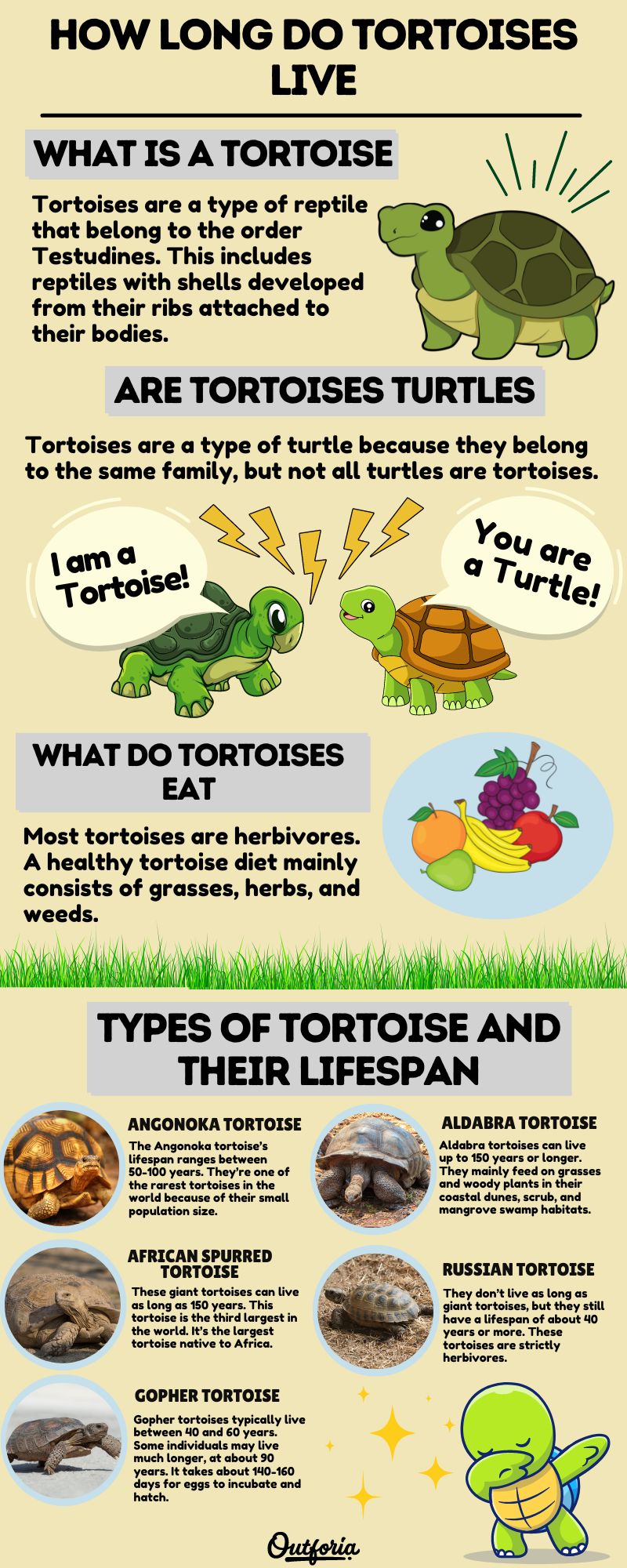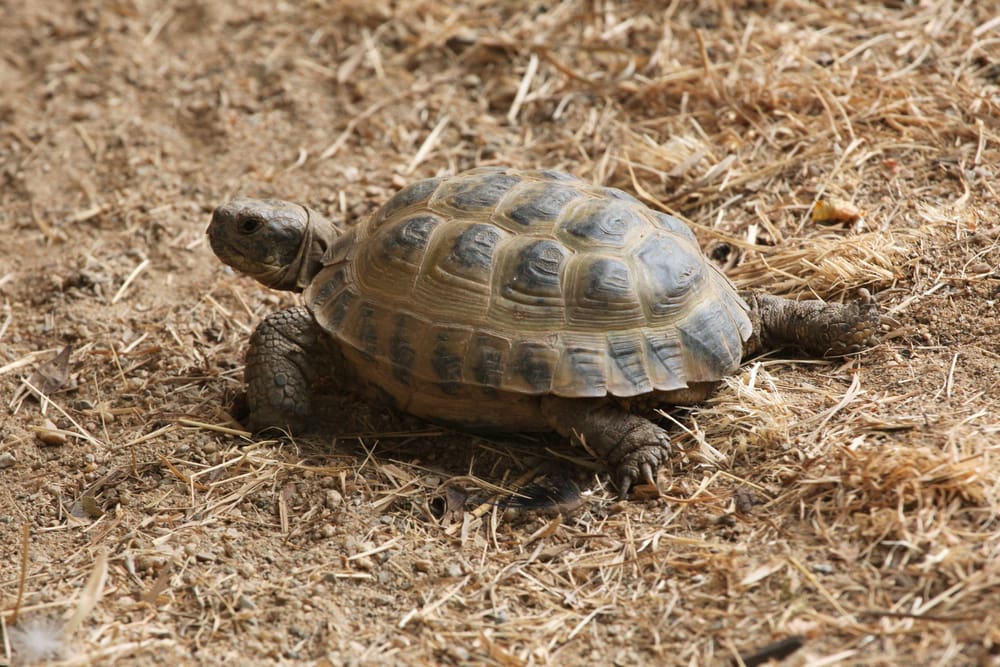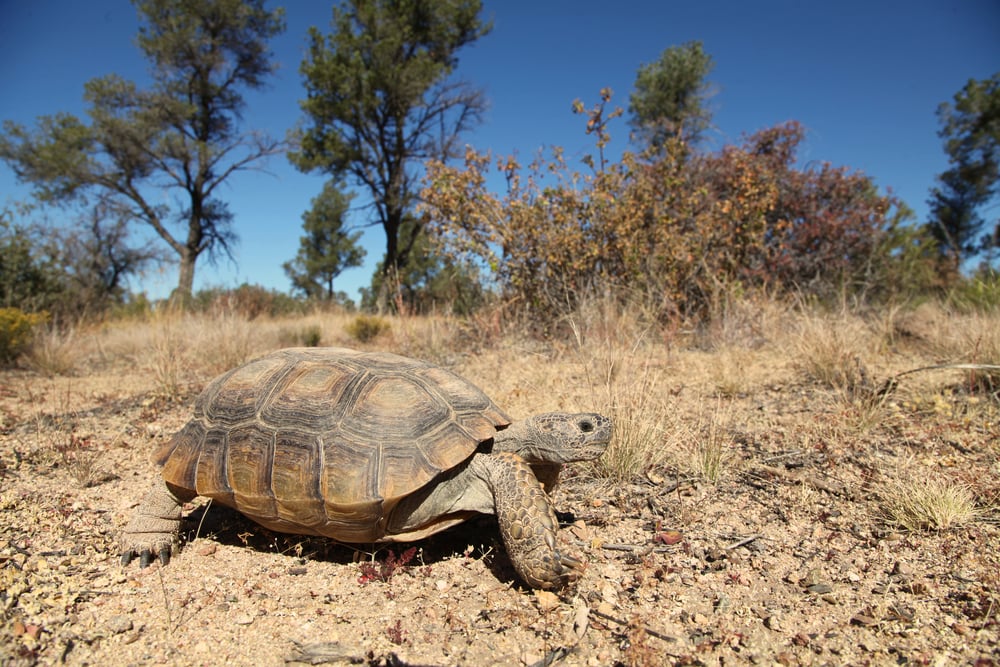Outforia Quicktake: Key Takeaways
- Tortoises are ancient, land-dwelling reptiles with lifespans ranging from 30 to over 150 years, depending on the species.
- Several factors affect a tortoise’s life, including natural and human-related factors, such as habitat loss, pollution, and climate change.
- Most tortoises are herbivores, and their diet can vary depending on their habitat and location.
- Tortoises are known for their ability to see color well and symbolize longevity, good luck, and wisdom in many cultures.
- Domesticated tortoises can bond with humans, but it is not advisable to touch or interact with wild tortoises.

Tortoises are land-dwelling creatures that have been around for millions of years. They’re known as the oldest living animals on Earth. They’re also popular pets for reptile lovers. Many tortoise species can live at least half of a human life, but some outlast a whole human lifespan!
Have you ever wondered exactly how long do tortoises live? The lifespan of a tortoise can differ depending on what species of tortoise it is.
Here we have some examples of different types of tortoises, how long they can live, and other neat facts about these ancient animals.

Share This Image On Your Site
You May Also Like: All 7 Different Types Of Sea Turtles: Pictures, Classification & Facts
What Is a Tortoise?

Tortoises are a type of reptile that belong to the order Testudines. This includes reptiles with shells developed from their ribs attached to their bodies.
Most tortoises and turtles belong to the suborder Cryptodira. These tortoises and turtles are known as hidden-necked turtles. They differ from the other suborder, Pleurodira, because they’re able to bring their head and limbs inside their shell.
Turtles belonging to the Pleurodira suborder are known as side-necked turtles. They tuck their heads sideways underneath their shell rather than inside it.
Tortoises fall under the family Testudinidae. The term tortoise and turtle are often used interchangeably depending on your location. But tortoises and turtles aren’t the same for several reasons.
Are Tortoises Turtles?

Tortoises are a type of turtle because they belong to the same family, but not all turtles are tortoises.
Tortoises are a land-dwelling species. They can survive for long periods without water. They live in dry, semi-arid environments. Most turtles have webbed feet or adaptations that allow them to travel in water. Turtles like habitats near water.
The flat shell that most turtles have helps them glide through water easily. A tortoise shell is more dome-shaped, except for a few species.
Tortoises have larger, stumpy legs that are better for walking on land. Both of these creatures can lay eggs and regulate their own body temperature.
Tortoise Lifespan

Tortoises are an egg-laying species. Once hatched, they become completely independent. After a female lays eggs, it takes an average of 100-160 days for the eggs to incubate. Some tortoise species may take as little as 60 days, while others can take more than 250 days.
Juveniles grow at a slightly faster rate than adults. However, it still takes most juvenile tortoises at least 10-20 years to reach sexual maturity.
Once a tortoise has matured, it can reproduce. This is also when their metabolism slows dramatically. Their slow metabolism causes them to develop at a much slower pace. The slow metabolism of adult tortoises is why these creatures live so long.
An adult will continue to reproduce each year. Most species have a lifespan of over 50 years. Some species may only live for about 30 years or a little more. Others are capable of living as long as 150 years or more.
What Do Tortoises Eat?

Most tortoises are herbivores. A healthy tortoise diet mainly consists of grasses, herbs, and weeds.
A tortoise’s diet can also vary widely depending on where they live and what their habitat is like. Tortoises that live in desert-like environments will snack on cacti and cacti fruits.
Some tortoises may occasionally eat insects, but much of their diet is made up of plants. A carnivorous diet can actually be harmful to species that mainly have an herbivorous diet.
Many tortoises in captivity are fed leafy greens, fruits, and veggies. Iceberg lettuce isn’t a good snack for turtles or tortoises. This is because it lacks much-needed nutrients. Feeding a tortoise an iceberg lettuce-based diet can lead to starvation.
Where Do Tortoises Live?

Tortoises live in many parts of the world on most continents. The only continents they’re not found on are Australia and Antarctica.
A handful of tortoise species are native to North America. There are several species endemic to Africa and Eurasia.
Habitats can vary depending on the type of tortoise and what region they live in. Most tortoises live in dry environments because they can withstand hotter temperatures. Tortoises are burrowers. They create burrows in the ground to keep cool.
Semi-arid environments are common tortoise habitats. They can be found in deserts, grasslands, savannas, or even forests. Some live in coastal habitats on islands, such as the Galapagos Islands.
How Long Do Tortoises Live?

A tortoise’s lifespan largely depends on the species and its environment. Some tortoises can live more than 150 years, while others have a much shorter lifespan.
Some of the oldest-living tortoises have been estimated to be over 200 years old. However, records of the longest-living tortoise don’t reach this number. The longest-living tortoise is a Seychelles giant tortoise (Aldabrachelys gigantea hololissa) named Jonathan.
Jonathan the tortoise is the oldest-living tortoise in the world at 190 years old as of 2022. He surpassed the age of Tu’i Malila, a tortoise that lived to be 188 years old.
Jonathan was brought to St. Helena in 1882 as an adult from the Seychelles Archipelago. He was believed to be at least 50 years old at the time. He’s believed to be born sometime around 1832, but he may be even older.
Types of Tortoise and Their Lifespan
Although some tortoises can outlive humans by an extra lifetime, others don’t live nearly as long. Lifespans between different tortoise species can range anywhere between 30 to over 150 years.
Angonoka Tortoise (Astrochelys yniphora)

The Angonoka tortoise is considered one of the rarest in the world. There are less than 600 individuals living on the island of Madagascar. They live in the northwestern part of the island in the Baly Bay area.
Their habitat consists of bamboo scrub savannas that have shrub thickets and palms. The environment is hot and semi-humid.
They reach sexual maturity at around 20 years of age. Egg incubation can take as long as 280 days. A clutch generally consists of only four hatchlings per year. The Angonoka tortoise’s lifespan ranges between 50-100 years. They typically live longer in captivity with proper veterinarian care.
They’re one of the rarest tortoises in the world because of their small population size. Their low clutch size and slow sexual development contribute to their diminishing population.
African Spurred Tortoise (Centrochelys sulcata)

The African spurred tortoise lives in the southern region of the Sahara Desert in northern Africa. They live in areas that contain scrub, savannas, and semi-arid grasslands.
This tortoise is the third largest in the world. It’s the largest tortoise native to Africa. They can weigh as much as 200 pounds (91 kg).
African spurred tortoises are burrowing creatures that can conquer the Sahara’s hot temperatures. They can last without food for weeks at a time if needed during the hottest times of the year.
These tortoises mature and can reproduce at around 15 years of age. Females typically lay 15-30 eggs, which take about eight months to incubate before hatching. These giant tortoises can live as long as 150 years.
Gopher Tortoise (Gopherus polyphemus)

Found in the eastern half of North America is the gopher tortoise. They’re a rare sight but can be found mainly in southern Georgia and Florida. Their range used to extend to other southern states, including:
- South Carolina
- Alabama
- Mississippi
- Louisiana
They’re almost extinct in Louisiana and South Carolina. They might be spotted in Mississippi and Alabama, but they’ve become increasingly rare.
A gopher tortoise is a small tortoise compared to larger species like the African spurred tortoise. They average about 10 pounds (4.5 kg) in adulthood. They also have a shorter lifespan than many other tortoise species.
Gopher tortoises typically live between 40 and 60 years. Some individuals may live much longer, at about 90 years. It takes about 140-160 days for eggs to incubate and hatch.
However, only a fraction of the eggs laid hatch, and the chances of hatchling survival are very low. The high mortality rate for hatchlings and slow sexual maturity make them vulnerable.
Much of the gopher tortoise population decline is related to substantial habitat loss. They prefer habitats in longleaf pine forests, which used to be abundant in the southeast.
Due to human activity and deforestation, much of their habitat has been destroyed. The gopher tortoise is considered a keystone species because its burrows provide shelter for other animals.
Aldabra Tortoise (Geochelone gigantea)

The Aldabra tortoise is a giant tortoise weighing as much as 550 pounds (249 kg). They reside on Aldabra Island, an atoll located in Seychelles in the Indian Ocean. These tortoises are the largest living animals on the island.
Aldabra tortoises can live up to 150 years or longer. They mainly feed on grasses and woody plants in their coastal dunes, scrub, and mangrove swamp habitats.
These tortoises are intelligent and can be easily domesticated. They also sleep a lot! Giant tortoises tend to sleep around 18 hours each day.
Russian Tortoise (Testudo horsfieldii)

The Russian tortoise is one of the most common tortoises kept as a pet. They’re fairly small, only reaching about 10 inches (25.4 cm) in length as adults. They’re originally found in Russia, Iran, Afghanistan, and Pakistan. They’re often referred to as Afghan tortoises.
They live in the rocky deserts of these regions. However, they’re commonly found in pet stores in the US. They’re collected from their native habitats and sent overseas to the US to be sold as pets.
They don’t live as long as giant tortoises, but they still have a lifespan of about 40 years or more. These tortoises are strictly herbivores.
You May Also Like: How Long Do Sea Turtles Live? All About Their Best Kept Secret
What Factors Affect a Tortoise’s Life?

Several factors contribute to a tortoise’s lifespan, including natural and human-related. Many tortoises need to live in their native range and natural habitats.
One of the main causes of tortoise extinction is human activity paired with their slow reproductive rate. Habitat loss poses a huge threat to many tortoise species. Other human-related factors include:
- Pollution
- Capture for pet trade
- Invasive species
- Climate change
Population decrease can also be attributed to consumption as a food source for some parts of the world. Pollution can force tortoises to find new homes within their range. Invasive species introduction can lead to increased predation, especially on eggs and juveniles.
Many tortoise species have already gone extinct, mainly due to human activity. Several species are currently labeled as vulnerable, threatened, or endangered. The African spurred tortoise is an endangered species due to habitat alteration.
Fun Facts about Tortoise

Tortoises can see color well.
Many reptile species don’t have very good eyesight. Tortoises and turtles are actually able to see very well. They can also detect bright colors. This helps them identify brightly-colored fruits and flowers to feed on.
Tortoises are ancient animals.
Tortoises have been around for millions of years. They first appeared on Earth in the Triassic period. Some of the earliest species emerged approximately 230 million years ago. Later species appeared about 23 million years ago.
Tortoises are symbols of longevity and good luck.
Tortoises symbolize longevity, good luck, and wisdom in many cultures. In Chinese culture, the tortoise symbolizes longevity and power. Tortoises have also appeared in old folklore tales and literature for hundreds of years. Aesop’s fable, The Hare and the Tortoise, is a famous tale that’s lived on for centuries.
You May Also Like: All The 26 Types Of Texas Turtles (ID Guide And Photos)
Tortoises FAQ

Can tortoises swim?
Tortoise legs and shells aren’t designed for water. Most turtles can swim because of their flat shells and webbed feet. A tortoise’s body is made so it can live entirely on land.
They may be able to float in water. However, their body and shell aren’t designed for swimming. If they wander into water, they can risk drowning.
Are tortoises edible?
Giant tortoises are edible. They can be eaten as long as proper preparation steps are taken to remove anything harmful for human consumption. Turtle soup is a common delicacy in China and Southeast Asian countries.
Do tortoises like to be touched?
Wild tortoises don’t like to be touched. Interacting with or touching a tortoise in the wild can actually be harmful to them. Many tortoises urinate if they’re picked up as a fear response or when they feel threatened.
Tortoises as pets, however, may like to be touched by their owners. If they’re comfortable with their owner, they might enjoy some pets or being handled.
Can a tortoise bond with a human?
Yes, a tortoise can bond with a human. Tortoises bonded with their owners will typically approach the owner to seek attention. Their displays of affection aren’t the same as a cat or dog. However, they’re still capable of recognizing and appreciating their owner.
Why do tortoises scream?
Tortoises don’t actually scream because of their lack of vocal cords. Instead, they can release air that mimics the sound of a scream. They expel air from their lungs to help make space for their body in their shell.
A turtle hissing while retracting in its shell is a sign that it feels threatened and wants to be left alone.









